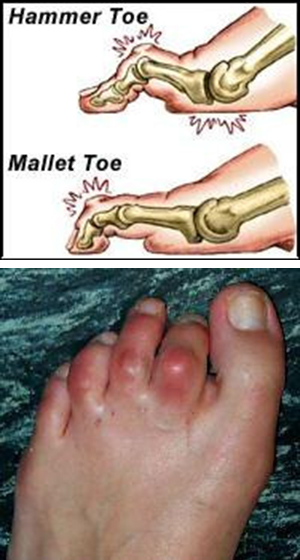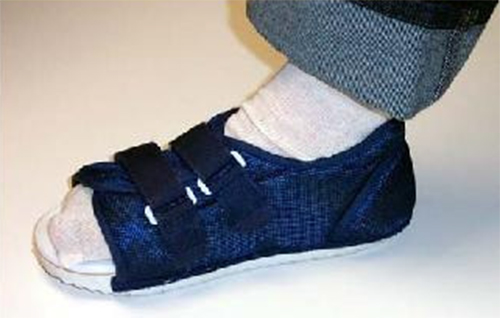 This is an operation to correct deformities of the toes other than the big toe, usually “hammer” or “claw” toes.
This is an operation to correct deformities of the toes other than the big toe, usually “hammer” or “claw” toes.
The main issue with this deformity is a problem with the ligament under the knuckle joint (plantar plate).
When a “hammer” or “claw” toe is painful, causes the toe to rub in the shoe or causes pressure in the ball of the foot, and cannot be accommodated in a shoe, surgery would be considered. Some people prefer to have shoes with extra depth and possibly an insole provided.
Others do not like such shoes, or are not comfortable in them.
THE SURGERY
One of the following two operations are performed, sometimes in combination.
- A cut is made across the top of the toe. If several toes are operated on at the same time, each toe has its own cut. The joint in the middle of the toe is opened and some bone removed to allow correction of the deformity.
- The ligament under the knuckle joint (MTP) needs to be retightened. This is done by cutting the metatarsal bone and shortening it (it is often long).
This gives access to the ligament. It is repaired with tight suture. This restores the alignment of the toe and alleviates pain, but allows normal fixation of the joint. A single screw is used to fix the bone.
CAN IT BE DONE AS A DAY CASE OPERATION ?If you are medically fit, have someone who can collect you and look after you after the operation, and you are comfortable afterwards, the operation can be done on a day case basis. However, if you have other medical problems such as diabetes, asthma or high blood pressure, you may have to be admitted the day before for tests and stay overnight after surgery. If you cannot be collected and looked after you must stay overnight to avoid complications. If you are having many toes operated on, especially if both feet are involved, it may be best to stay in overnight to allow swelling to go down. This will be discussed with you when you are offered surgery. |
WILL I HAVE TO GO TO SLEEP (GENERAL ANAESTHETIC)?The operation is usually done under general anaesthetic (asleep). Occasionally, an injection in the back, leg or around the ankle can be done to make the foot numb while the patient remains awake. Your anaesthetist will advise you about the best choice of anaesthetic for you. In addition, local anaesthetic may be injected into your leg or foot while you are asleep to reduce the pain after the operation even if you go to sleep for the surgery. You will also be given pain-killing tablets as required. |
WILL I HAVE A PLASTER ON AFTERWARDS ?No plaster is necessary,a post operative shoe is fitted at the time of the surgery. Some people also have a bunion corrected, or an operation for arthritis of the big toe, at the same time. |
 FOLLOWING YOUR SURGERY
FOLLOWING YOUR SURGERY
-
ON THE WARD
Usually dressings and a bandage will be put on your foot and you can walk on it in a protective sandal with a stiff sole straight after the surgery. You can put as much weight as comfortable through this, preferably through the heel. Once you are comfortable you are discharged from hospital.
-
WHEN YOU GO HOME
It is very important that the leg remains elevated most of the time in the first 2 weeks – rest is important. Do not wet or remove the dressings.
It is normal to expect:
-
SWELLING – this can be minimised by elevating your foot above your heart; icing the foot may be helpful
-
PAIN – You will receive a prescription for pain medication on discharge from hospital. Pain can also be minimised by elevating your leg.
-
BLEEDING – This always occurs. You may notice some oozing through the bandages.
Further AppointmentsYou will be seen again about 10-14 days after surgery to check the wound and the toe. Your toe will be dressed again and you will be shown how to tape your toe correctly. You will be expected to repeat this at home as required. It is very important to exercise the toe and joint at this stage. You will be seen again 4 weeks later. An xray will be performed. At this stage, the swelling will be much improved, and all dressings will be removed. The taping should continue for another 4-6 weeks to ensure the toe stays in the correct position. |
HOW SOON CAN I….
-
WALK ON THE FOOT?
You can walk on the foot immediately after surgery. The ball of the foot may be rather sore after the toe is straightened so you may wish to put most of your weight on your heel for the first week or two. You will have a stiff shoe provided which will relieve pressure in the front of the foot.
-
GO BACK TO WORK ?
If your foot is comfortable, and you can keep your foot up and work with your foot in a special shoe, you can go back to work within a few days of surgery. On the other hand, in a manual job with a lot of dirt or dust around, you may need to take anything up to two months off work. How long you are off will depend on where your job fits between these two extremes.
-
DRIVE?
If you have only your left foot operated on and have an automatic car you can drive within a few days of the operation, when your foot is comfortable enough. Most people prefer to wait until they can wear a shoe.
-
PLAY SPORT?
After 6 weeks, all being well, you can start taking increasing exercise. Start with walking or cycling, building up to more vigorous exercise as comfort and flexibility permit. Most people can get back to their previous level of activity within 3-4 months of surgery. Full recovery may take up to 6 months.
IF YOU ARE CONCERNED:
|
